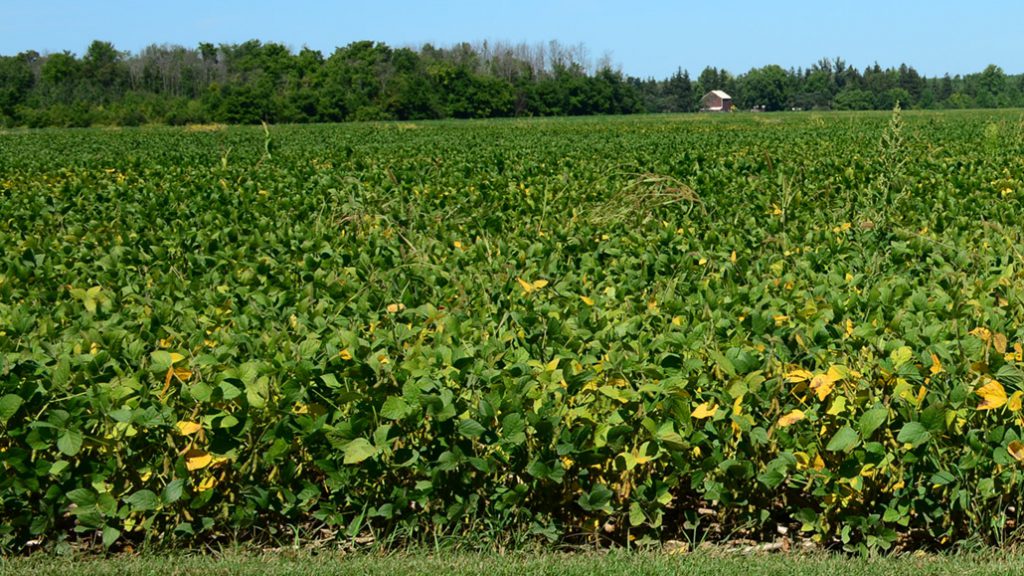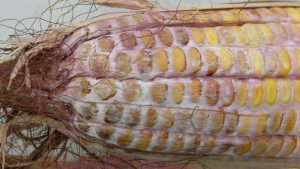Preventing pest damage in soybeans
UNTANGLING THE METABOLIC FACTORS of RESISTANCE

ONTARIO SOYBEAN GROWERS contend with many challenges each year, from cold and wet springs to potential pre-harvest frost to diseases and pests. If the threat to yield from two prominent pests — soybean aphids and two-spotted spider mites (TSSM) — can be mitigated through research and eventually through new variety development, that would be very welcome by growers.
Grain Farmers of Ontario has provided funding for a research project with this in mind, led by Agriculture and Agri-Food Canada scientists Dr. Ian Scott and Dr. Sangeeta Dhaubhadel. For two years, they have been analyzing a group of popular Ontario soybean cultivars to find out how much they differ in resistance to these pests, and how the metabolic underpinnings of resistance differ as well.
A plant’s resistance to an insect pest has a lot to do with which compounds are present in the leaves and stem, as well as how much. If there is more of a compound that a pest doesn’t like, less plant will be consumed and the pest’s impact on yield will therefore be smaller. And while insecticides can be used to control soybean aphids and TSSM, these crop protection products can also kill ‘good’ insects such as ladybugs, lacewings and parasitic wasps that prey on these pests.
PLANTS FIGHT BACK
The defensive compounds in soybean leaves that are disliked by these pests are known as isoflavonoids and flavonoids. In soybeans, the types and amounts of these compounds found in a particular plant depends on its genetics, but also on environmental factors such as temperature. In addition, whether or not a particular soybean plant generally produces less or more of these compounds, it will start producing more of these compounds in response to pest or even pathogen attack. In other words, once attacked, the plant fights back as quickly as it can.
In their study, Scott and Dhaubhadel found that among a group of 12 Ontario soybean cultivars, those with the greatest resistance to aphids, in decreasing order, were OT06-22, OT06-23, OAC Strive, Harosoy 63, OAC Avatar and AC Colombe. The most resistant to TSSM were OAC Avatar, followed by OAC Wallace, Pagoda, OAC Lakeview, OT06-22 and OT06-23.
“We observed that only a few of the cultivars were similar in terms of their resistance to both herbivores,” says Scott. “This was new information that had not previously been reported.”
It was also determined that the cultivar most resistant to aphids is as much as almost 40 times more resistant than the most susceptible, but the range among the cultivars for TSSM resistance is not as large.
“This was expected in the sense that we knew that spider mites are a generalist herbivore, whereas soybean aphids are specialists on soybean,” Scott explains. “TSSM are better able to adapt to a large range of plant defenses, at least during the time period of our trials. They have a greater ability to detoxify the defense compounds. In addition, a recent study in our lab also indicates that spider mites can adapt to resistant cultivars over several generations, metabolizing more of the plant’s defensive compounds through the use of particular enzymes.”
So, while it’s clear that soybean cultivars resistant to aphids are not necessarily resistant or tolerant to spider mites, there is another dimension. While soybean aphids and TSSM both feed by sucking nutrients from leaves, aphids siphon the contents of the phloem (the tubes in which sugars and more are transported within a plant), while mites pierce the plant tissue to feed on the contents of individual leaf cells. The types of cells damaged as well as the recognition of oral secretions specific to each herbivore are important in determining the plant’s defense response.
Scott and Dhaubhadel have also gathered new information on soybean and insect pest interactions, profiling the differences in compound types found in the more susceptible and more resistant cultivars. These compounds fall mostly in the isoflavone and flavonol classes.
“We learned that these metabolites were found in greater amounts in resistant cultivars compared to susceptible cultivars, as expected, and also that levels increased when the aphid and spider mites were feeding,” say Dhaubhadel and Scott. “However, there are also some unknown metabolites that accumulate differentially in resistant versus susceptible cultivars and identification of these may allow for better ‘marking’ of the trait.”
OAC AVATAR STANDS OUT
Overall, the cultivar that can be recommended to growers as having the best resistance to both pests is OAC Avatar. In the 2019 Ontario Soybean Variety Trials, it had a similar number of seeds per kg as other cultivars in this study and was also one of the higher-yielding maturity group 1 cultivars, comparable to OAC Calypso. (OAC Calypso was one of 18 cultivars that the team initially screened for total isoflavonoid concentrations and was one not chosen for the aphid and mite resistance trials, but OAC Lakeview was tested; it is similar to OAC Avatar in agronomic traits but was less resistant to aphids and had lower isoflavonoid leaf levels. No 2019 agronomic data for either Harosoy 63 or OT06-23 are available.)
While OAC Avatar is already used in breeding programs, longtime soybean breeder and professor in the Department of Plant Agriculture at the University of Guelph, Dr. Istvan Rajcan, says he is excited to possibly use it for breeding more insect-resistant soybean lines in the future. He says he and his team often use OAC Avatar in crosses, “not just because of herbivore resistance but for its other agronomic and seed quality traits.” While Scott and Dhaubhadel have shared their research results among soybean breeders in Canada, they have also presented it internationally, for example, at the recent 10th Spider Mite Genomics meeting in Europe.
This research project received funding from Grain Farmers of Ontario. •

























